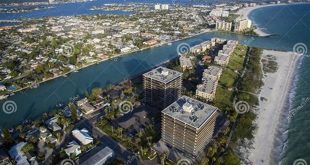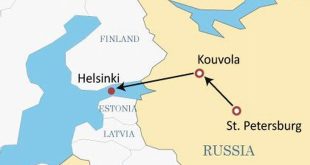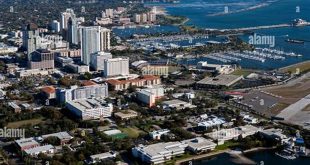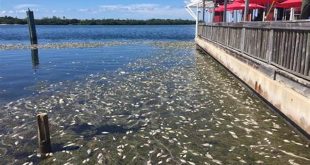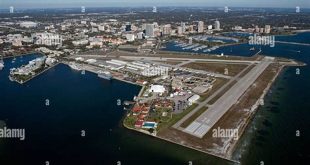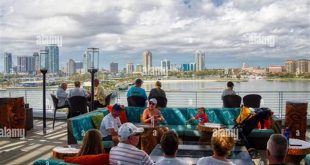St. Petersburg is a city in western Russia, located on the Neva River at the head of the Gulf of Finland. It is the second-largest city in Russia after Moscow, with a population of over 5 million people. St. Petersburg is a major cultural and economic center, and it is home to many world-renowned museums, theaters, and other cultural institutions.
Editor’s Note: Our “Where is St. Petersburg?” guide was last published on July 4th, 2023. We update our guides regularly to ensure the information is as current and accurate as possible.
We’ve done the research and put together this guide to help you learn more about St. Petersburg. Whether you’re planning a trip or just want to learn more about this fascinating city, we hope you find this information helpful.
Key Takeaways
| St. Petersburg | |
|---|---|
| Country | Russia |
| Region | Northwestern Federal District |
| Population | 5,383,890 |
| Area | 1,439 square kilometers (555 square miles) |
| Founded | 1703 |
Main Article Topics
- History of St. Petersburg
- Geography of St. Petersburg
- Culture of St. Petersburg
- Economy of St. Petersburg
- Transportation in St. Petersburg
- Tourism in St. Petersburg
Where is St. Petersburg?
St. Petersburg is a city with a rich history, vibrant culture, and a major economic center. To fully understand “where is St. Petersburg?”, we must explore its various dimensions:
- Location: Northwestern Russia, on the Neva River at the head of the Gulf of Finland.
- Country: Russia
- Region: Northwestern Federal District
- Population: Over 5 million people
- Area: 1,439 square kilometers (555 square miles)
- Founded: 1703
- Climate: Humid continental, with warm summers and cold winters.
- Culture: Rich in art, music, theater, and literature.
These key aspects provide a comprehensive understanding of St. Petersburg’s location, demographics, history, and culture. Its unique position on the Neva River and the Gulf of Finland has shaped its development as a major port and shipbuilding center. The city’s rich cultural heritage is evident in its world-renowned museums, theaters, and architectural landmarks. As a major economic center, St. Petersburg is home to a diverse range of industries, including manufacturing, tourism, and finance.
Location
The location of St. Petersburg in northwestern Russia, on the Neva River at the head of the Gulf of Finland, has played a pivotal role in its development and significance.
Firstly, its location on the Neva River provided access to the Baltic Sea, facilitating trade and commerce. This strategic position allowed St. Petersburg to become a major port city and a gateway to Europe. The city’s shipbuilding industry also flourished due to the abundance of natural resources in the region.
Secondly, St. Petersburg’s location at the head of the Gulf of Finland provided a natural harbor, protecting it from harsh weather conditions and enemy attacks. This made St. Petersburg an ideal location for Russia’s naval base and contributed to its rise as a major naval power.
In addition, the city’s proximity to Europe exposed it to Western ideas and culture, influencing its architecture, art, and overall development. St. Petersburg became a center of learning and innovation, attracting scholars, artists, and intellectuals from across the continent.
| Location | Impact on St. Petersburg |
|---|---|
| Northwestern Russia | Access to natural resources, proximity to Europe |
| Neva River | Trade, commerce, shipbuilding |
| Gulf of Finland | Natural harbor, protection from harsh weather |
Understanding the connection between St. Petersburg’s location and its development is crucial for grasping the city’s historical, cultural, and economic importance. Its strategic position has shaped its destiny, making it a major player in Russian and European affairs.
Country
To fully understand “where is St. Petersburg?”, we must explore its connection to Russia, the country in which it is located. Russia’s vast territory, rich history, and cultural diversity have significantly influenced the development of St. Petersburg.
-
Political and Administrative Center
As the political and administrative center of Russia, St. Petersburg has played a pivotal role in shaping the country’s destiny. It was the capital of the Russian Empire from 1712 to 1918 and remains a major political and administrative hub today. The city is home to the Russian government, parliament, and other important institutions.
-
Economic Powerhouse
St. Petersburg is a major economic powerhouse within Russia. It is home to a diverse range of industries, including manufacturing, shipbuilding, tourism, and finance. The city’s strategic location on the Neva River and the Baltic Sea has facilitated trade and commerce for centuries.
-
Cultural Capital
St. Petersburg is renowned as Russia’s cultural capital. It is home to world-class museums, theaters, and architectural landmarks. The city has played a significant role in the development of Russian art, music, and literature. Many artists, writers, and musicians have lived and worked in St. Petersburg.
-
Gateway to Europe
St. Petersburg’s location on the Baltic Sea has made it a gateway to Europe. The city has served as a bridge between Russia and Western Europe for centuries. St. Petersburg has been influenced by European culture and ideas, which is evident in its architecture, art, and overall development.
In conclusion, the connection between “Country: Russia” and “where is St. Petersburg?” is multifaceted and profound. St. Petersburg’s political, economic, cultural, and geographical significance are deeply intertwined with Russia’s history and identity.
Region
To fully grasp “where is St. Petersburg?”, we must explore its connection to the Northwestern Federal District, one of the eight federal districts of Russia. The district encompasses 11 constituent entities, including St. Petersburg, and plays a crucial role in the city’s development and significance.
-
Economic Center
The Northwestern Federal District is a major economic center within Russia. It is home to a diverse range of industries, including manufacturing, shipbuilding, forestry, and agriculture. St. Petersburg, as the district’s largest city, serves as a hub for economic activity and contributes significantly to the region’s overall prosperity.
-
Transportation Hub
The Northwestern Federal District is a vital transportation hub, connecting Russia to Europe and other parts of the world. St. Petersburg is a major port city and a key gateway for international trade. The city’s strategic location on the Neva River and the Baltic Sea has facilitated the development of a robust transportation infrastructure, including railways, highways, and airports.
-
Cultural Heritage
The Northwestern Federal District is rich in cultural heritage, with St. Petersburg being a prime example. The city is home to world-renowned museums, theaters, and architectural landmarks. It has played a significant role in the development of Russian art, music, and literature. Many famous artists, writers, and musicians have lived and worked in St. Petersburg.
In conclusion, the connection between “Region: Northwestern Federal District” and “where is St. Petersburg?” is multifaceted and profound. The district’s economic, transportation, and cultural significance are deeply intertwined with St. Petersburg’s development and identity.
Population
The population of St. Petersburg is a significant aspect that shapes its identity and contributes to its status as a major metropolis. With a population of over 5 million people, St. Petersburg is the second-largest city in Russia and ranks among the most populous cities in Europe.
-
Economic Hub
A large population provides a substantial workforce and a vast consumer base, contributing to St. Petersburg’s economic growth and vitality. The city is a major center for industries such as manufacturing, shipbuilding, tourism, and finance.
-
Cultural Vibrancy
A large population supports a diverse and vibrant cultural scene. St. Petersburg is renowned for its world-class museums, theaters, and architectural landmarks. It attracts artists, musicians, and performers from across Russia and the globe.
-
Transportation and Infrastructure
A large population requires a well-developed transportation system and infrastructure. St. Petersburg has an extensive network of public transportation, including metro, buses, and trams, as well as a modern airport and seaport.
-
Urban Planning and Development
A large population necessitates careful urban planning and development. St. Petersburg has implemented innovative approaches to housing, green spaces, and sustainable development to ensure a high quality of life for its residents.
In conclusion, the population of over 5 million people is a defining characteristic of St. Petersburg, contributing to its economic prosperity, cultural vibrancy, and overall development as a major metropolis.
Area
Understanding the area of St. Petersburg, which spans 1,439 square kilometers (555 square miles), is crucial in grasping the city’s geographical context and its implications for various aspects of urban life.
-
Geographic Significance
St. Petersburg’s vast area encompasses a diverse landscape, including the city center, suburbs, and surrounding natural spaces. This geographic diversity contributes to the city’s unique character and offers a wide range of living environments.
-
Urban Planning and Development
The city’s extensive area has allowed for careful urban planning and development. St. Petersburg boasts well-defined districts, efficient transportation networks, and ample green spaces, ensuring a high quality of life for its residents.
-
Economic Growth
St. Petersburg’s large area provides ample space for economic activities. The city is home to major industrial zones, commercial hubs, and research institutions, contributing to its economic prosperity and job creation.
-
Cultural and Recreational Opportunities
The city’s vast area accommodates a multitude of cultural and recreational venues. St. Petersburg is renowned for its world-class museums, theaters, parks, and sports facilities, offering a diverse range of leisure activities for residents and visitors alike.
In conclusion, the area of 1,439 square kilometers (555 square miles) is an integral aspect of “where is St. Petersburg.” It shapes the city’s geographic landscape, urban development, economic growth, and cultural offerings, contributing to St. Petersburg’s status as a major metropolis.
Founded
The founding of St. Petersburg in 1703 is an event of profound significance in understanding “where is St. Petersburg.” It marked the birth of a city that would become a major metropolis and a cultural and economic powerhouse.
-
Historical Legacy
The founding of St. Petersburg was a deliberate act by Peter the Great, who envisioned a “window to Europe” and a modern, prosperous city. The city’s early history shaped its architectural style, cultural institutions, and political significance.
-
Geographic Location
The location chosen for St. Petersburg was strategic, at the head of the Gulf of Finland and the mouth of the Neva River. This location facilitated trade, shipbuilding, and naval defense, contributing to the city’s rapid growth and importance.
-
Cultural and Architectural Heritage
St. Petersburg was designed as a grand and beautiful city, with wide boulevards, elegant palaces, and magnificent churches. The city’s architecture reflects a blend of European influences, particularly Dutch and Italian, and has become a major tourist attraction.
-
Economic Development
St. Petersburg’s strategic location and its status as a major port city contributed to its economic prosperity. The city became a center for shipbuilding, manufacturing, and trade, and played a vital role in Russia’s economic development.
In conclusion, the founding of St. Petersburg in 1703 is a pivotal event that has shaped the city’s location, history, culture, and economic development. Understanding this historical context is crucial for fully grasping “where is St. Petersburg” and its significance in Russia and the world.
Climate
The humid continental climate, characterized by warm summers and cold winters, is a defining component of “where is St. Petersburg.” This climate significantly influences the city’s lifestyle, infrastructure, and overall character.
The warm summers, with average temperatures ranging from 15C to 25C (59F to 77F), provide a pleasant environment for outdoor activities, tourism, and cultural events. The city’s parks, gardens, and waterways come alive during this period, offering residents and visitors ample opportunities for recreation and relaxation.
In contrast, the cold winters, with average temperatures dropping below freezing, require adaptation and resilience from the city’s inhabitants. Heavy snowfall and icy conditions necessitate proper infrastructure, reliable heating systems, and winter-friendly urban planning. The city’s buildings and architecture often incorporate design elements to withstand the harsh winter climate.
The distinct seasons of St. Petersburg shape the daily lives of its residents. Winter sports and activities, such as ice skating, cross-country skiing, and snowshoeing, become popular during the colder months. In the summer, boating, swimming, and park picnics are common leisure pursuits.
Furthermore, the climate influences the city’s economy and tourism industry. Winter tourism, including ice festivals and cultural events, attracts visitors from around the world. The city’s infrastructure and services are adapted to cater to both summer and winter tourism, supporting local businesses and employment.
In summary, the humid continental climate is an integral part of “where is St. Petersburg.” It shapes the city’s lifestyle, infrastructure, economy, and overall character, creating a unique and dynamic urban environment.
Culture
St. Petersburg is renowned for its vibrant and diverse cultural scene, which has played a significant role in shaping the city’s identity and attracting visitors from around the world.
-
Art
St. Petersburg is home to world-class art museums, including the Hermitage, which houses one of the largest and most comprehensive collections of paintings, sculptures, and other works of art in the world. The city’s art scene also encompasses contemporary galleries, street art, and public installations, showcasing the creativity and talent of local and international artists.
-
Music
St. Petersburg has a rich musical heritage, with a thriving classical music scene centered around the Mariinsky Theatre, one of the most prestigious opera and ballet companies in the world. The city is also known for its jazz, rock, and folk music venues, offering a diverse range of live music experiences.
-
Theater
St. Petersburg boasts a thriving theater scene, with numerous theaters offering a wide variety of performances, from classical plays to contemporary productions. The city is home to the Alexandrinsky Theatre, one of the oldest and most respected theaters in Russia, as well as many smaller and experimental theaters showcasing innovative and thought-provoking works.
-
Literature
St. Petersburg has been a literary hub for centuries, inspiring and nurturing some of Russia’s greatest writers, including Fyodor Dostoevsky, Alexander Pushkin, and Nikolai Gogol. The city’s literary legacy is celebrated in its many museums, bookstores, and literary festivals, attracting book lovers and literature enthusiasts from around the globe.
The rich culture of St. Petersburg is a fundamental aspect of “where is St. Petersburg.” It contributes to the city’s unique character, attracts visitors, and enhances the quality of life for residents. The city’s cultural institutions, events, and creative community play a vital role in shaping St. Petersburg’s identity as a vibrant and dynamic cultural center.
Frequently Asked Questions about “Where is St. Petersburg”
This section addresses some common questions and misconceptions surrounding “where is St. Petersburg,” providing concise and informative answers.
Question 1: Where exactly is St. Petersburg located?
St. Petersburg is situated in northwestern Russia, on the Neva River at the head of the Gulf of Finland.
Question 2: Is St. Petersburg the capital of Russia?
No, Moscow is the capital of Russia. St. Petersburg served as the capital of the Russian Empire from 1712 to 1918.
Question 3: What is the significance of St. Petersburg’s location?
St. Petersburg’s strategic location on the Neva River and the Gulf of Finland has made it a major port city, a gateway to Europe, and a center for shipbuilding and trade.
Question 4: What is the population of St. Petersburg?
St. Petersburg has a population of over 5 million people, making it the second-largest city in Russia.
Question 5: What is St. Petersburg known for?
St. Petersburg is renowned for its rich culture, including world-class museums, theaters, and architectural landmarks. It is also known for its shipbuilding industry and its role as a major economic center.
Question 6: Is St. Petersburg a good place to visit?
Yes, St. Petersburg is a popular tourist destination, offering a wide range of cultural attractions, historical sites, and scenic waterways.
Summary: Understanding “where is St. Petersburg” involves exploring its geographical location, historical significance, cultural heritage, and modern-day importance. This multifaceted city continues to captivate visitors and residents alike with its unique blend of history, culture, and urban vitality.
Transition: Continue reading to delve deeper into the history, culture, and other aspects of St. Petersburg.
Tips for Understanding “Where is St. Petersburg”
To fully grasp “where is St. Petersburg,” consider these insightful tips:
Tip 1: Explore its Geographical ContextTip 2: Trace its Historical Roots1703Tip 3: Immerse Yourself in its Vibrant CultureTip 4: Consider its Economic SignificanceTip 5: Appreciate its Architectural HeritageTip 6: Embrace its Modern Appeal
“where is St. Petersburg”
Conclusion
Our exploration of “where is St. Petersburg” has unveiled a city of profound historical significance, vibrant culture, and modern-day importance. St. Petersburg’s strategic location, architectural marvels, and cultural institutions have shaped its unique identity and global recognition.
Understanding “where is St. Petersburg” encompasses appreciating its geographical context, tracing its historical roots, immersing in its vibrant culture, considering its economic significance, and embracing its modern appeal. St. Petersburg continues to captivate visitors and residents alike, offering a captivating blend of history, culture, and urban vitality.

